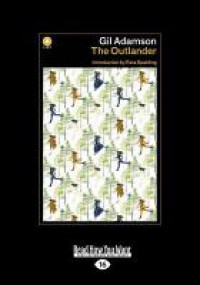The Outlander (Adamson)

Honestly, I can't imagine what Anansi Press was thinking, letting this first novel go out into the world with a title so similar to that of a pop-culture phenomenon. Otherwise, though, they have done well by Gil Adamson in both production and editing, and I'm very glad they published this interesting story.
Adamson deliberately distances us a bit from her characters. They are "the Reverend", "the Ridge Runner", the "Widow." The significance of "the widow" as the constant name for the protagonist -we don't get her real name until well into the book - is that it keeps at the top of our minds exactly what is always at the top of hers - that she has murdered her husband. And that same distancing relieves us of the responsibility of empathizing with her more than we want to, though you'd have to have a pretty black soul not to feel something by the end of her picaresque adventures through the Crows Nest Pass area in western Canada. The landscape is very definitely a character, and a cruel one, in this novel. It has its spectacularly climactic plot event in the Frank slide (a notorious 1903 landslide that wiped out a sizeable part of a mining town). I thoroughly enjoyed how well Adamson described it and wove it in to her story from several points of view.
The widow - Mary Boulton - is supported by a well-described set of supporting characters, one of whom, the reclusive Ridge Runner, becomes a romantic interest though not, thank goodness, in a conventionally sappy way that would have ruined everything we have come to know about both characters. I thought the inclusion of the Native characters was sufficiently nuanced and well-managed to meet the political correctness standards of our time, though Henry is a relatively minor character.
At the beginning of this novel, Mary is highly vulnerable, fumbling her way to survival and sometimes very nearly not making it. She is dependent on a series of saviours - an old lady (and her household), the Ridge Runner, Henry and his white wife Helen, and the Reverend Bonnycastle (working out his own demons of abuse in the rough mining town of Frank). But after she is finally caught by her slightly cartoonish Furies, a pair of red-headed giants (brothers of the ex-husband), Mary accomplishes her last escape from disaster without a saviour. This, I would say, is the principal emotional dynamic of the novel.
I did find this one a bit of a page-turner, and I would recommend it to anyone who likes period settings and interesting women's stories. I would warn off only those readers who have a strong need for emotional identification with a protagonist.



